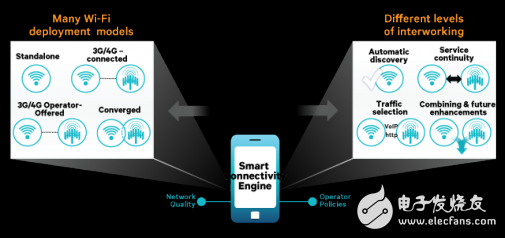Not long ago, when we first started talking about small cells, the first question we heard was always “Since we already have Wi-Fi, why do we need small cells?†But now, this question has rapidly evolved into "How can we achieve stable and seamless collaboration between 3G / 4G and Wi-Fi networks?" In the near future, the amount of mobile data will increase by a factor of 1,000. In the face of such challenges, such collaboration will become more important. Qualcomm envisages solving this challenge by intensively deploying small base stations, most of which have integrated Wi-Fi connections. The integration and interworking of 3G / 4G and Wi-Fi are multi-dimensional, including different deployment modes and multi-level cooperation. Let's take a look at some details. Depending on the degree of integration, the most basic and current mainstream deployment model is an independent Wi-Fi network operated by a third-party provider, which can connect signaling to authorized or certified 3G / 4G networks. The higher level mode is that 3G / 4G operators provide Wi-Fi networks or services themselves, which is often referred to as "operator Wi-Fi". In this case, the connection between the two networks may not only include a signaling connection, but also establish a data connection. The most integrated mode takes a converged solution, providing both 3G / 4G and Wi-Fi networks in the same box, such as small base stations based on Qualcomm converged AP solutions. This is also the most likely deployment method for small base stations. Accordingly, in terms of integration level, the most basic third-party independent Wi-Fi is that without any user intervention, the 3G / 4G terminal can automatically search and connect to the Wi-Fi network, that is: use PasspointTM ( Aka Hotspot 2.0). The higher level is based on operator policy, intelligent choice between 3G / 4G and Wi-Fi connection. For example, operators may want to provide high-quality services and their own services through 3G / 4G networks, and offload other services such as web browsing, downloads, and OTT services through Wi-Fi networks. The highest level of collaboration is to provide seamless continuous service between 3G / 4G and Wi-Fi networks. This means that the terminal can not only automatically search for and connect to a Wi-Fi network, but also seamlessly transfer data sessions between networks, and users will not even be aware of these switches. The higher-level collaboration mentioned here can already support all the situations mentioned above. In addition, it can combine data from two connections or networks to make it more compact and stable. 3GPP is currently trying to implement these advanced functions in Rel. 11 or higher. No matter what deployment mode is adopted or which level of collaboration is supported, the terminal will always be able to select the best access among 3G / 4G networks and numerous Wi-Fi connections at any given time. Of course, network selection needs to refer to certain standards and operator policies, but suppliers can provide additional intelligent technology to further optimize the selection, so there is still a great opportunity to achieve differentiation. For example, Qualcomm's CnE intelligent connection engine, which is part of the terminal chipset, also integrates more intelligent algorithms to select the best network connection. So in general, there are many ways to achieve effective collaboration between 3G / 4G and Wi-Fi, and there is also a clear roadmap to make collaboration more reliable and seamless. In my next blog, I will discuss how Qualcomm USA has realized this vision. For more information, please visit our website Outdoor Trolley Power Supply,Solar Energy Storage,Outdoor Charging Station,Outdoor Storage Battery Sichuan Liwang New Energy Technology Co. , https://www.liwangnewenergy.com